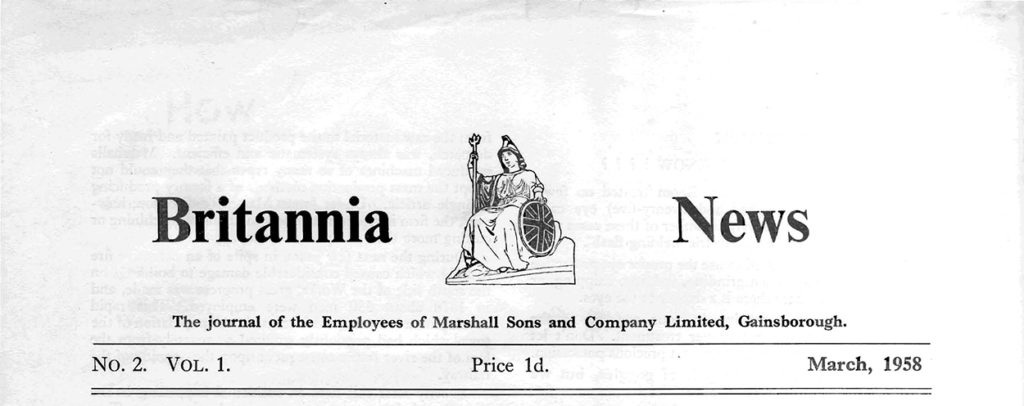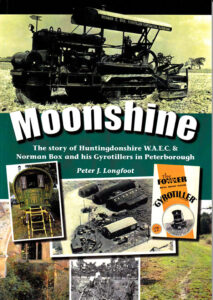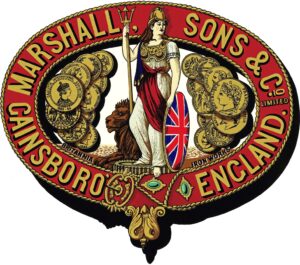Marshall History Pt.2 Britannia News 1958
- At July 6, 2019
- By Andrew Birkitt
- In History
 0
0

Our readers will recall that in our last issue we covered the history of the Company from its inception by William Marshall in the year 1848 until his death in the year 1862, when his sons, James and Henry Marshall, assumed control.
James and Henry quickly realised that to expand the business they would require more capital. In 1862 they formed a Joint Stock Company, and the firm acquired its present name Marshall Sons and Company Limited. James Marshall was the Chairman and Managing Director, Henry Dickenson Marshall was Joint Managing Director and Secretary.
The two brothers were a perfect combination for industry and commerce. James looked after the engineering side, and Henry after the commercial and administrative sides of the business. If any difference of opinion arose between them, they would debate the matter until they arrived at a decision, which they would then announce to their fellow directors, and loyally abide by.
James Marshall’s engineering genius is shown by the manner in which the expanding Works were continuously adapted to meet new demands. The site was originally covered by old buildings, and could be obtained only by small sections. Nevertheless, the routing of manufacture, from the raw material to the product painted and ready for despatch, was always systematic and efficient. Marshalls produced machines of so many types that they could not adopt the mass production methods of a factory producing a single article. Under James Marshall’s direction, however, the firm invented many new methods of machining or cutting more than one part at a time.
During the next few years, in spite of an extensive fire in 1864 which caused considerable damage to buildings on the south side of the Works, great progress was made, and in 1870 about 550 men were employed. This rapid development led to a great increase in the population of the town which had previously suffered so severely from the loss of the river traffic consequent upon the opening of the railway.
Shortly after this date an accidental happening in the Far East led to a very important development. Two Scottish brothers, William and John Jackson, who were Tea Planters in Assam, had invented many new devices for withering, rolling, drying, cutting, sifting, firing and packing tea, and had ordered a number of machines from the United Kingdom. On reaching Assam, these machines broke down, and the Jacksons set out for home to make other arrangements. As they were proceeding by river en route to Calcutta, their vessel was held up by some mishap, and to pass the time the two brothers visited a near-by plantation. Here they saw a portable engine driving a centrifugal pump for irrigation, and were told that this engine had been working for ten years without a hitch.
They made a note of the maker’s name and address: “Marshall Sons and Company Limited, Gainsborough.” On arriving in England, they came to Gainsborough and arranged with Marshalls that the latter should produce tea machinery in accordance with the Jacksons’ ideas.
It is related that, before sending the first machines out to the Far East, James Marshall himself tested them. Tea not being available in sufficient quantity, elder-leaves were used as a substitute. A heap was produced of what looked like the finest black tea-but when James Marshall carried the test a stage further, by making a brew of the product, the result was not pleasant.
Shortly after this, John Jackson went to the United States, but William Jackson remained in association with Marshalls until his death in 1915. A standard American work of tea production comments: “The mechanical genius of the members of the Marshall family played an important part in finding solutions of the engineering problems presented in the working out of many of Mr. Jackson’s ideas.” In 1884 Marshalls produced the first mechanical hot air drier. Another of their most notable nineteenth century produ~ was the “Rapid” Roller, first produced in 1887. Over 250 of these machines were sold in 1889, and they ruled the market for twenty years. The present Marshall’s Tea Machinery Company, founded in 1934, inherits the tradition that originated in the break-down of a river-steamer in the early seventies.
In 1876 the first traction engine was built. It was not constructed for heavy haulage work, but for ordinary farm purposes. In view of this, we might claim that Marshalls have specialised in the construction of the farmer’s tractor since that date.
By 1885 the Britannia Works covered 16 1/2 acres and the two decades before the end of the century were ones of increasing activity and expansion.
Kelly’s directory for 1889 records that Marshalls then employed some 2,500 workpeople.
Some difficulty was encountered in building the new portions of the works until a new process was invented which made it possible to make bricks out of clay which was present on the site.
The extraordinary spectacle of a hill surrounded by a wall could then be seen, and as the hill was dug out to get the clay for bricks the walls grew taller, until finally the New Boiler Shop was completed. The shop itself was for many years the largest Boiler Shop in Europe, being ultimately surpassed in size only by Krupps of Essen, in Germany. At about the same time the old Foundry was enlarged to twice its original size.
Henry Marshall, on the administrative side, was one of the first industrial employers to encourage inventiveness amongst employees by welcoming new ideas and by paying for those adopted. He also took a keen interest-at a time when few employers did so-in the education of his work people. In 1884 he organised classes in the firm’s office buildings, with teachers and equipment provided by Marshalls. Engineering courses were given in machine drawing, mechanics and physics, and commercial courses in English, French, book-keeping and shorthand. (To be continued)

